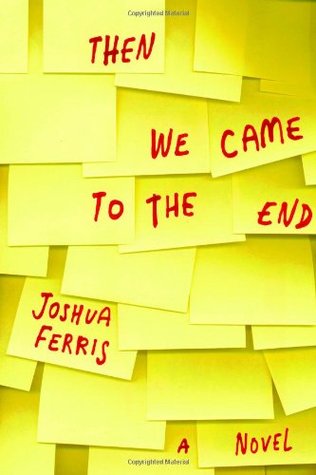Humans of New York by Brandon Stanton
by Sam de Figueiredo, opinions editor
While reading Humans of New York, I was struck by how the photographs conveyed unexpected emotions. Each page of the book contained only a few pictures and corresponding captions. I therefore thought the book would be a quick read. However, after getting lost for several minutes while studying the details of the first photo, I realized I was wrong. Every portrait depicts a person that seems initially familiar, as if I had seen them in the grocery store or at the mall. However, after reading the short sentences at the bottom of each page, I found that the distinct personalities of each subject emerged. This eye-opening book reminded me that seemingly ordinary people have unique and compelling stories.
Then We Came to the End by Joshua Ferris
by Drew Howerton, senior executive editor

When We Came to the End by Joshua Ferris is about the people who work in a Chicago advertising agency during the Dot-Com boom of the late 1990s and early 2000s as they navigate the day-to-day of office life, pulling pranks on coworkers and struggling with a vague pro bono project, all while under the threat of being laid off at anytime for any reason. The novel has a unique twist in that it’s written from the perspective of a collective “we”, with “we” being the voice of every person in the office building. As characters in the office are fired or “walked Spanish down the hall” as the characters refer to it, “we” refers to fewer and fewer people as the book goes on. Of course, there are still prominent characters in the novel: Tom Mota, a recently divorced copywriter who wears three company shirts on top of each other and quotes Ralph Waldo Emerson in order to avoid conforming, Jim Jackers, a quirky graphic designer who is constantly left out of the loop and is the laughing stock of the office, Joe Pope, a mysterious workaholic who is the subject of office pranks, Marcia Dwyer, a tomboy who is the object of affection for Benny Shassburger, the “most liked person in the office”. These characters are only a handful of those mentioned in the book, as each event that happens at the office seems to focus on everybody at once, instead of focusing in on one person entirely. Ferris presents an interesting point of view by making every character both central and minor to the story, making the whole novel read like the sensation of being a part of a family, rather than an outsider looking in, as most novels are presented. When characters are laid off, it feels like losing a family member and this book is the first to make me cry in a very long time. Not only does Then We Came to the End explore the relationships between coworkers, it also discusses the idea of working in a modern society. Jobs aren’t necessarily things we want, but they are required in order to function and thrive in society. Then We Came to the End makes me wonder why things are the way they are; why do we sacrifice our lives to a routine nine to five, besides paying bills and taxes and having money for a rainy day? The novel presents work almost as a foreign concept – hardly any work actually gets done throughout the course of the book, making everything seem almost futile. Reading Then We Came to the End made me almost want to quit my job. Almost. Until I remembered that I too have things that need to be paid. I walked away from Then We Came to the End with a newfound appreciation for life, because life is too way short to worry about my job or money, when I could spend that time learning new things and loving the people I’m around.
The God of Small Things by Arundhati Roy
by Olivia Conway, co-online editor
 I can best describe The God of Small Things as a quiet earthquake of a novel. It tiptoes in, leaves you shaken to your core, and tiptoes out again. Roy’s language flows like water and her descriptions of both people and landscapes in late-1960s India are wonderfully vivid. The God of Small Things recounts the experiences of fraternal twins Estha and Rahel as they struggle to live after the death of their cousin, Sophie. In this novel, Roy plays with time and frequently shifts between the present day, where the twins are adults and attempting to finally understand the tragedy that destroyed their family, and the days surrounding Sophie’s death, where the twins and Sophie are young children. This book is a literary masterpiece for multiple reasons. First, Roy depicts emotionally traumatic events through the eyes of her seven-year-old protagonists, an impressive feat that effectively distances the reader from the events taking place. With this approach Roy forces readers to consider the complexities of life in a new way, which I think encourages empathy and emotional understanding. Second, in fewer than four hundred pages Roy manages to craft detailed backstories and distinctive personalities for an astonishing number of characters. We not only become familiar with Estha, Rahel, and Sophie, but also with extended family members and the village’s communist leader. Finally, while the family drama surrounding Sophie’s death and the relationships between the different characters stand in the forefront, The God of Small Things also addresses the political issues of the time. Issues of caste relations and the rise of communism provide a chaotic backdrop to the story. The instability shown in the society as a whole as it teeters between two vastly different political structures is also reflected within the family, although on a much smaller scale. The emotional power of The God of Small Things and its lessons of family and forgiveness make it a difficult novel to forget.
I can best describe The God of Small Things as a quiet earthquake of a novel. It tiptoes in, leaves you shaken to your core, and tiptoes out again. Roy’s language flows like water and her descriptions of both people and landscapes in late-1960s India are wonderfully vivid. The God of Small Things recounts the experiences of fraternal twins Estha and Rahel as they struggle to live after the death of their cousin, Sophie. In this novel, Roy plays with time and frequently shifts between the present day, where the twins are adults and attempting to finally understand the tragedy that destroyed their family, and the days surrounding Sophie’s death, where the twins and Sophie are young children. This book is a literary masterpiece for multiple reasons. First, Roy depicts emotionally traumatic events through the eyes of her seven-year-old protagonists, an impressive feat that effectively distances the reader from the events taking place. With this approach Roy forces readers to consider the complexities of life in a new way, which I think encourages empathy and emotional understanding. Second, in fewer than four hundred pages Roy manages to craft detailed backstories and distinctive personalities for an astonishing number of characters. We not only become familiar with Estha, Rahel, and Sophie, but also with extended family members and the village’s communist leader. Finally, while the family drama surrounding Sophie’s death and the relationships between the different characters stand in the forefront, The God of Small Things also addresses the political issues of the time. Issues of caste relations and the rise of communism provide a chaotic backdrop to the story. The instability shown in the society as a whole as it teeters between two vastly different political structures is also reflected within the family, although on a much smaller scale. The emotional power of The God of Small Things and its lessons of family and forgiveness make it a difficult novel to forget.

